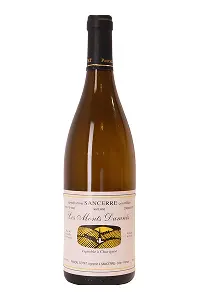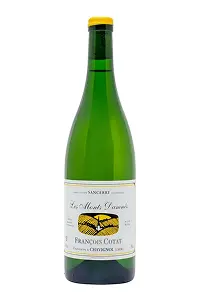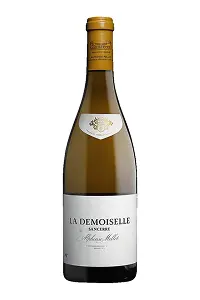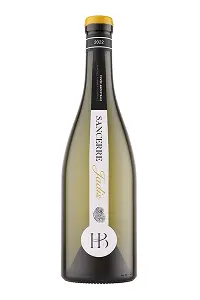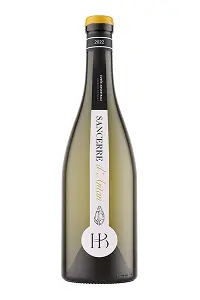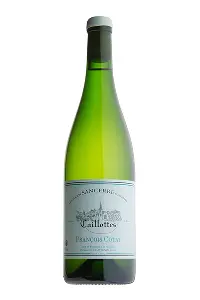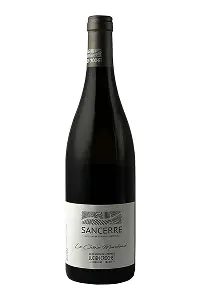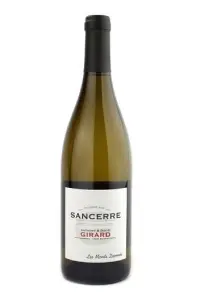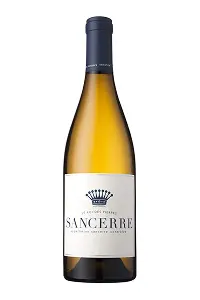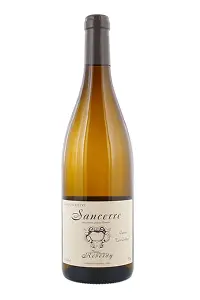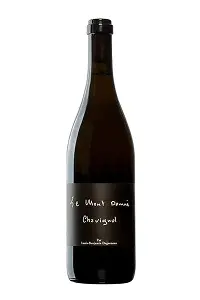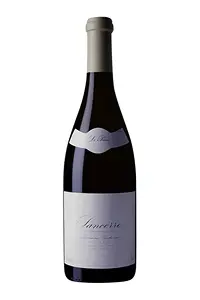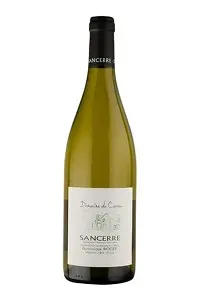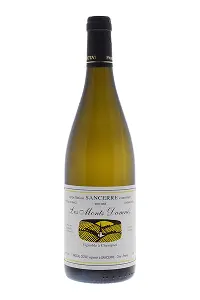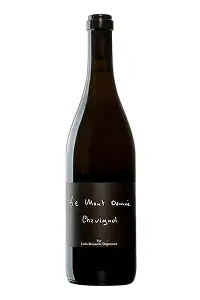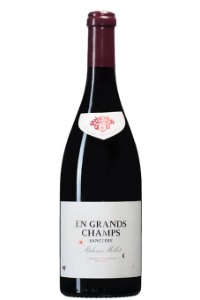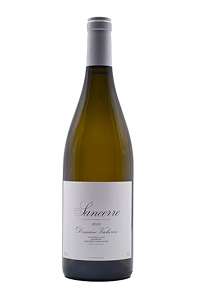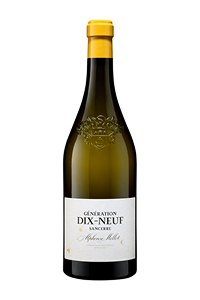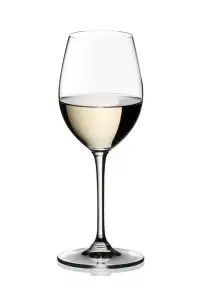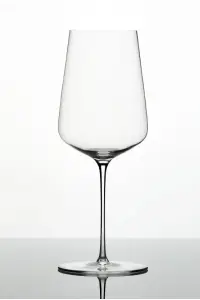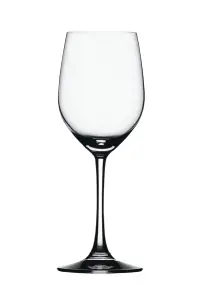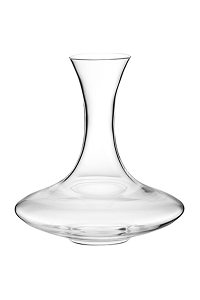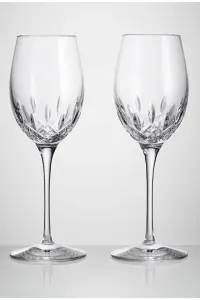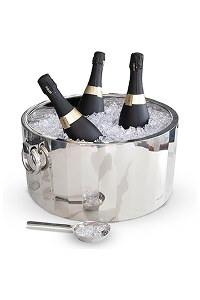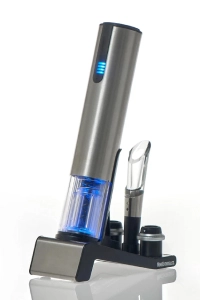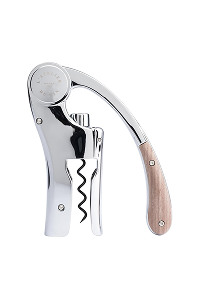Sancerre wine: great bottles you need to try
Sancerre wine has earned its reputation as one of France’s most celebrated exports. In this guide, we’ll take a look at the best Sancerre wines of 2025, share its story and give tips on how to enjoy this classic made from Sauvignon Blanc grapes.
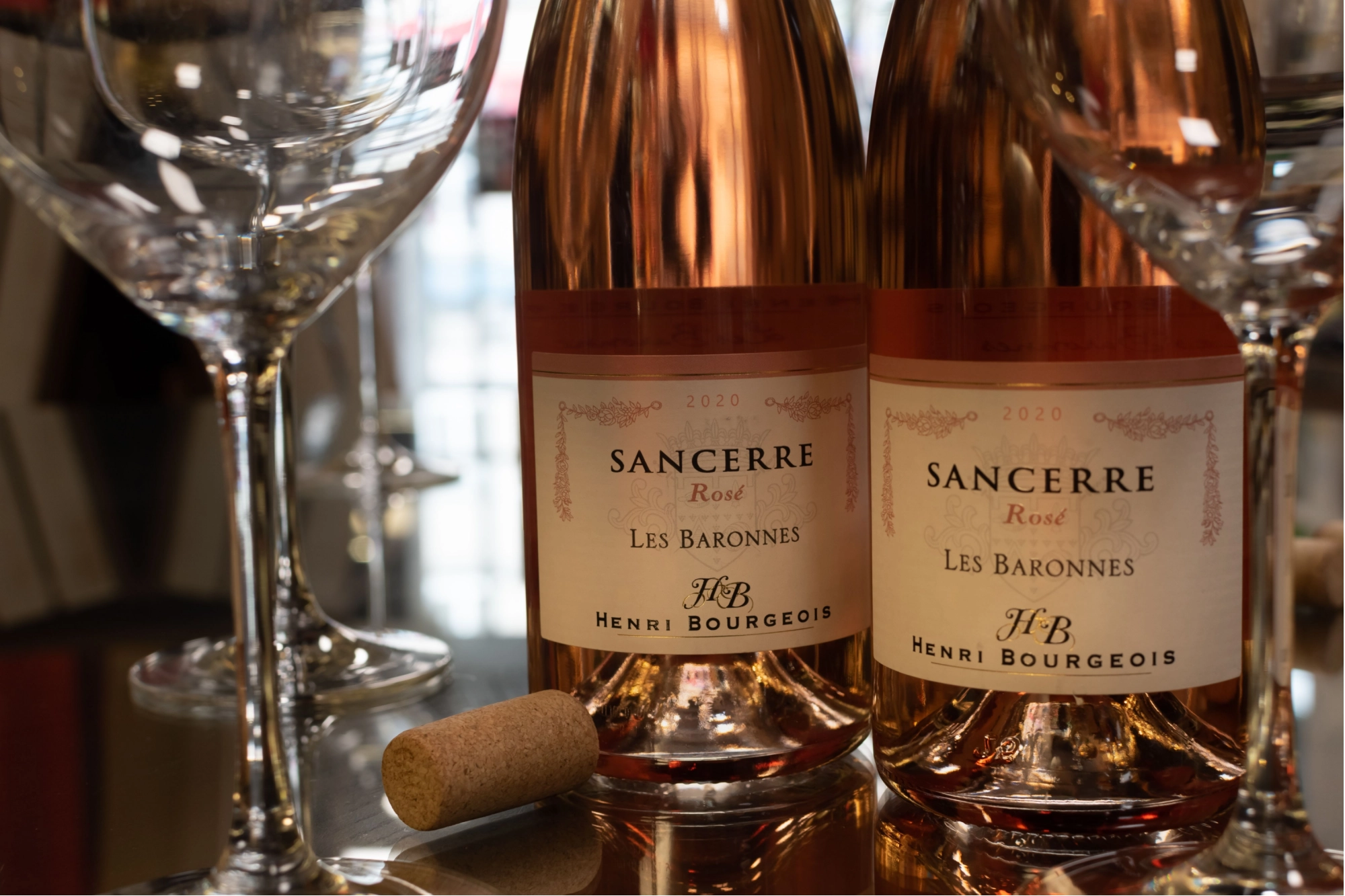
By
Last updated:
Table of Contents
Top rated Sancerre wines for 2025
Sancerre Le Monts Damnes – Pascal Cotat 2023
France
Le Monts Damnes Sancerre – François Cotat 2023
France
La Demoiselle Sancerre Blanc – Alphonse Mellot 2021
France
Sancerre Jadis – Henri Bourgeois 2022
France
Sancerre d’Antan – Henri Bourgeois 2022
France
Caillottes Sancerre – François Cotat 2023
France
Le Chêne Marchand Sancerre – Lucien Crochet 2022
France
Sancerre Le Monts Damnes – Anthony & David Girard 2022
France
Sancerre – Le Roi des Pierres 2023
France
Couvée Les Coutes Sancerre – Pascal & Nicolas Reverdy 2023
France
In the list above, you’ll find our current selection for the 10 top rated Sancerre wines each showing Sancerre’s bright, crisp and mineral elegance along with ratings, tasting notes and standout vintages. We update this selection as winemakers release new bottlings, come back regularly so you don’t miss out on new gems!
Sancerre white wine at a glance
| Sancerre Wine | Details |
|---|---|
| Grape Variety | 100% Sauvignon Blanc |
| Origin | Sancerre AOC, Loire Valley (France) |
| Serving Temperature | Between 46 and 54°F |
| Decanting | Not necessary |
| Aging Potential | 3 to 8 years |
| Flavor Profile | Citrus, fresh herbs, mineral, floral notes |
| Structure | Light to medium bodied, bright acidity, lively freshness |
| Alcohol Content | 12.5% to 13.5% |
| Ideal Glass | Medium white wine glass or tulip shaped glass |
| Food Pairing | Fresh goat cheese, seafood, salads, grilled fish, light dishesFresh goat cheese, seafood, salads, grilled fish, light dishes |
| Top Communes | Sancerre, Chavignol, Bué, Saint-Satur |
| Notable Producers | Pascal Jolivet, Domaine Vacheron, Alphonse Mellot, Domaine Henri Bourgeois |
So what makes Sancerre white wine taste so different from all the other Sauvignon Blancs out there? It’s not just the grape, it’s the land! Nestled in the rolling hills of the Loire Valley, Sancerre’s vineyards grow in soils rich in flint, limestone and clay. This unique mix is what gives these wines their fresh and mineral vibe.
Here’s a quick look at the Sancerre wine tasting notes:
- Citrus fruits: zesty lemon and grapefruit pop right after the first sip.
- Green fruits: crispy green apple and pear bring juicy bursts of flavor.
- Herbaceous hints: there’s a subtle touch of freshly cut grass or herbs in the background.
- Minerality: a chalky, almost stony e gives the wine a distinct sense of place.
- Floral touches: sometimes you catch white flowers or elderflower in the aroma, which gives it a delicate and soft note.
What is Sancerre wine? How is it made?
Sancerre is a French wine produced in the eastern part of the Loire Valley strictly under the AOC (Appellation d’Origine Contrôlée) Sancerre appellation. Although the most famous Sancerre wine is white, made from 100% Sauvignon Blanc grapes, the appellation also produces high quality rosé and red wines using Pinot Noir grapes. Sancerre’s characteristics are strongly influenced by the cool weather, the mix of soils and the way winemakers handle the grapes. Let’s see in detail how Sancerre white wine is made (vinification):
- Harvesting and grape selection: vineyard parcels are picked individually when grapes reach optimal ripeness, often by hand. Damaged or underripe berries are removed from the grapes so that only clean clusters reach the press.
- Pressing: most estates use whole cluster pressing (i.e. including stems) to keep bitterness low and the juice clear. A few winemakers add a short, cool skin soak into the process to nudge aromatic notes without roughness.
- Cold settling (débourbage): the juice (must) rests cold for about 12 to 48 hours so grape solids naturally sink. The clear juice is then racked (moved off the sediment) into tanks. A small dose of SO₂ (sulfur dioxide) and inert gas is then inserted into the wine to prevent browning and aroma loss.
- Fermentation: most Sancerre white wine ferments in cool and temperature controlled stainless steel tanks to keep flavors fresh and zesty. Some winemakers use neutral barrels, large casks, concrete or egg shaped tanks for a silkier feel to avoid oak flavors penetrating the wine. Winemakers use cultured yeasts (more reliable) or indigenous yeast (more vineyard specific) to promote fermentation. Most Sancerre white wine is made without malolactic fermentation (MFL) to preserve its crispiness and acidity but a few producers have started experimenting with MFL on specific cuvées (for example Domaine Hippolyte Reverdy’s Cuvée Ortus) to soften the wine introducing complexity and buttery notes.
- Aging on lees (élevage): after fermenting the wine rests on fine lees (the sediment that appears after pressing and during fermentation consisting, in this case, mainly in yeasts) for weeks or months according to the creaminess and length that the winemaker wishes to give to the wine. Some winemakers might also briefly perform an additional step which is called bâtonnage which means stirring the sediment back into the wine for extra silkiness, others skip it to keep maximum tension and minerality.
- Assembly (by soil and site). Sancerre has three classic soils that shape style: Caillottes (limestone pebbles) give fragrant wines; terres blanches (Kimmeridgian marl) add depth and structure; silex (flint) brings a linear profile with a faint smoky note. Many estates blend parcels while prestige bottlings may use fermented single soil product.
- Finishing: a light bentonite fining (a natural clay) is added to keep the wine clear, then the wine is chilled so tartrate crystals (aka wine diamonds) don’t form (cold stabilization). A gentle filtration is performed to polish the wine.
- Bottling: most Sancerre white wine is bottled within 6 to 12 months to capture freshness.
- Aging: Sancerre is usually best young but some bottles can hang around 3 to 8 years, which makes them gain extra layers of flavor.
Sancerre’s numbers: winemakers produced around 193,000 hectoliters of Sancerre wine in 2023 and about 70% of it was shipped all over the world!
Good to know: AOC is France’s legal system that guarantees origin and sets rules on the grapes used for wine production. AOC rules apply also outside the wine production to include locally certified food products (think cheese for example).
Sancerre wine grapes and types explained
The most famous Sancerre wine grape is undoubtedly Sauvignon Blanc, a variety that loves the cool climates. In fact, over 80% of the Sancerre vineyards are planted with Sauvignon Blanc from which Sancerre white wines are made. Pinot Noir grape is used to produce red and rosés Sancerres, although only to cover around 15 to 20% of plantings. Let’s see in detail the minority Sancerres wine types:
- Sancerre rosé wine: light and refreshing, rosé Sancerre is crisp and bone dry with berry flavors and floral hints, great for sipping on a sunny day. It is usually the result of direct press of Pinot Noir grapes with fermentation occurring in stainless steel barrels to keep the taste fresh!
- Red Sancerre (Sancerre rouge): are a bit rarer and are light to medium bodied with flavors of cherries, raspberries and a little earthy hint. They’re increasingly sought after and the winemaking process is more delicate if compared to the white and rosé Sancerre types: the grapes are destemmed to remove unwanted bitterness and they’re aged in tank or old barrels.
Best Sancerre white wines from notable estates
Sancerre has dozens of excellent producers but a few names consistently establish the standards for clarity, terroir focus and cellaring potential. These famous estates are characterized by meticulous farming techniques and consolidated high quality winemaking which result in the best Sancerre white wine bottlings available on the market:
- Alphonse Mellot: Mellot’s signature winemaking is texture without heaviness. The flagship Edmond (old vine selection) pushes Sancerre into grand vin territory: layered citrus and stone fruit, finespun lees richness and a long limestone finish. These wines shine young but develop more complex aromas if aged 3 to 8 years.
- Domaine Vacheron: run by cousins Jean Laurent and Jean Dominique, Domaine Vacheron is one of the benchmarks for Sancerre white wines. They were one of the first to go fully biodynamic, showing meticulous farming, low yields and growing focus on single vineyard expressions.
- Didier Daguneau: often called the “Wild Man of Puilly” or “L’Enfant Terrible”, Didier Dagueneau pushed boundaries with organic viticulture, natural fermentations and daring barrel experiments. The estate, located within the Pouilly-Fumé appellation, expanded into Sancerre wines by securing an ultra steep parcel in the famous district of Monts Damnés in Cavignol. Though tiny and measuring just about half an hectare, the chalky limestones of the Sancerre’s parcel produce an immensely powerful, mineral and structured wine.
Great Sancerres wine bottles from famous brands
Didier Dagueneau Sancerre Le Mont Damné 2022 – France
Sancerre Le Pave – Domaine Vacheron – 2023 France
Alphonse Mellot Emond Sancerre Blanc 2020 – France
What influences the Sancerre wine price?
Sancerre can be a very inexpensive wine as well as a prized collector’s treasure. The Sancerre wine price is highly influenced by factors relating to winemaking choices and grape origin. Let’s see in detail the main elements that cause variation in Sancerre wine costs:
- Winemaking style: almost all white Sancerre is made from Sauvignon Blanc but single vineyard or prestige couvées normally have higher prices due to increased production costs.
- Producer reputation: popular Sancerres brands like Alphonse Mellot or Domaine Vacheron are naturally more expensive due to their age worthy and biodynamic bottlings.
- Terroir: then there’s the soil! Vines planted in limestone wines with that extra mineral punch but that usually bumps up the cost because rocky sites yield less fruit and demand more handwork, especially during harvesting.
- Vintages: the year of harvesting impacts greatly Sancerre’s prices. Cooler vintages produce leaner wines while warm and balanced years deliver exceptional concentration and depth. Collectors prize these standout vintages, driving demand and prices higher. Limited availability over time further pushes older vintages up in value, as well preserved bottles become more each passing year.
Scroll down for some examples of how Sancerre white wine prices can swing depending on style and producer.
1. Entry Level Sancerre: Domaine du Carrou Blanc 2023 – France
2. Mid – Tier Sancerre: Les Monts Damnes 2021 – Pascal Cotat – France
3. Single Vineyard: Sancerre Le Mont Damné 2022 – Didier Dagueneau – France
4. Collector Most Expensive Sancerre: Les Fondettes 2006 – Sauvion – France
The most expensive Sancerre wines worth collecting
Sancerre might not be the first name that comes to mind when thinking of collectible French wines. But here’s the twist: a few producers make Sancerres wines that are considered collection worthy thanks to their aging potential and complex aromas developing gracefully over time.
Though the Sancerres prices do not reach the ones for classic collectible bottles such as Chardonnay or Bordeaux, below are 3 of the most expensive Sancerre wines picked especially for collectors, based on finesse, aging power and winemaker’s reputation.
Sancerre Alphonse Mellot En Grands Champs Sancerre Rouge 2015 – France
Guigne Chèvres Sancerre 2023 – Domaine Vacheron – France
Alphonse Mellot Generation XIX Sancerre Blanc 2020 – France
A walkthrough the best Sancerre vintage years
Every Sancerre vintage is a bit of a surprise because nature calls the shots: warm and dry summers give riper grapes with higher alcohol and softer flavors while cooler and rainy years (like for example 2011) can result in less intense aromas and sugar, so winemakers have to work harder to keep the wine fresh and balanced.
Below, we’ve put together what we think are the best Sancerre vintages to help collectors, sommeliers and fans discover some gems.
| Vintage | Best Sancerre Wines | Vintage Characteristics |
|---|---|---|
| 2022 | Sancerre Les Chambrates 2022 – Domaine Vacheron | Excellent growing season that was warm and dry. Wines became fresh and precise with a good aging potential. |
| 2015 | Sancerre Jadis 2015 – Henri Bourgeois | Warm and dry season that gave ripe, rich but quite balanced wines with a good structure. |
| 2014 | Sancerre Blanc 2014 – La Poussie | Cool and very balanced vintage. Fresh acidity and pure aromatics can be found in those wines. |
| 2010 | Sancerre Etienne Henri 2010 – Henri Bourgeois | Cool and fresh vintage, which means wines have more acidity and minerality. |
| 2005 | Sancerre La Vigne du Larrey 2005 – Gitton Père et Fils | One of the warmest vintages that resulted in ripe and round wines with a fuller body. |
| 2002 | Sancerre 2002 – Pascal Jolivet | What can be called a classic vintage: well balanced Sancerres with elegance and minerality are the outcome. |
Sancerre wine guide for beginners
Sancerre wine is one of the most approachable options for newcomers to the world of wine, thanks to its high minerality and balanced freshness. It is easy to enjoy, pairs well with a wide variety of dishes and to make things even better, here are three extra tips you’ll love:
- Start with Sancerre white wine bottles as they are more beginner friendly. Most Sancerre wines are meant to be enjoyed young and zippy, so starting with younger bottles (which means typically from 2 to 5 years old) is a smart approach.
- Sancerre loves the company of lighter but savory dishes that highlight its minerality. Pair with goat cheese, seafood and light vegetable dishes.
- Give it a good chill and let it breathe for a few minutes before serving. This way the aroma opens up and the sharp edges mellow out just enough.
Below is a simple table to help you enjoy your first glass of Sancerre wine the right way:
| Sancerre White Wine | Our Recommendation | Best to Pair with |
|---|---|---|
| Young Sancerre (under 5 yrs) | Sancerre Blanc 2022 – Acamas | Goat cheese, grilled fish, salads, light pasta, vegetable dishes |
| Mature Sancerre (10+ yrs) | Les Marennes 2014 – Cave des Vins de Sancerre | Aged goat cheese, mushroom dishes, poultry with truffle, white meats |
Sancerre wine glasses: does the shape matter?
Ever poured a great wine into some random glass and then thought “why doesn’t it taste as good”? Well, the shape of the glass really does matter in how you smell it and taste the wine: about 80% of what we call “taste” is actually smell. Your nose is doing most of the work!
The ideal Sancerre wine glass is slightly narrow with a tulip shaped bowl. This design sends the wine’s citrus and floral aromas directly to the nose while keeping that zippy acidity and mineral vibe alive. Below are three of the best recommended glass styles and brands for Sancerres wines, conveniently available on Amazon:
1. Riedel Vinum Sauvignon Blanc Glasses Set of 2 – 12,3 oz – 8,5 inches
2. Zalto Denk’Art Universal Glass – 20,2 oz – 9,6 inches
3. Spiegelau Vino Grande White Wine Glasses – 17,6 oz – 8,8 inches
The regions behind top rated Sancerre wines
Sancerre is as French as it gets. Like, legally French! Top rated Sancerre wines are strictly controlled by the Appellation d’Origine Protégée (AOP) Sancerre, a stamp that sets precise rules on how they need to be made. The appellation Sancerre sets everything: where the grapes can grow, what grapes you’re allowed to use, how the vineyards are farmed, how the wine’s made and even the quality checks.
And just to clear it up, Sancerre isn’t anywhere in France. It’s only from certain vineyard parcels in the Loire Valley. The specific Sancerre wine regions covered by the appellation are:
- Sancerre (the village itself): this is the beating heart of the appellation. The soils are often called terres blanches (chalky clay limestone) giving wines plenty of minerality and that Sancerre “zing”.
Try a classic: Sancerre 2022 – Domaine Vacheron - Bué: sitting on a mix of flint, clay and limestone soils, wines here feel lively with citrus floral lift popping out. The southern exposures add ripeness and more roundness if compared to central Sancerre.
Try a classic: Les Romains Sancerre Blanc 2021 – Domaine Alphonse Mellot - Chavignol: this terroir is defined by its Kummeridgian marl (i.e. chalky clay with fossilized shells). Wines here often balance richness with refined elegance and smoky mineral notes.
Try a classic: Chavignol Sancerre Rose 2023 – Domaine François Cotat - Saint-Satur: located near the Loire river, the vineyards of Saint-Satur are planted on lighter alluvial soils mixed with limestone. This region produces softer fruit flavors of pear with a gentle earthy undertone.
Try a classic: Sancerre La Côte 2023 – Domaine Gérard Boulay - Verdigny: the combination of limestone slopes with clay soils yields wines with great aromatic delicacy. You’ll often find delicate flower notes on the nose carried by a persistent bright acidity.
Try a classic: Verdigny 2022 – Domaine Michel Girard - Ménétréol-sous-Sancerre: in this commune is known for its stony, silex rich soils which translate into sharp, crisp wines with a striking minerality and vibrancy. These are some of the most energetic wines in the Sancerre appellation.
Try a classic: Sancerre 2023 – Domaine Pascal Jolivet Pascal Jolivet - Crézancy-en-Sancerre: with a mix of lighter soils and favorable exposures, this commune tends to produce more fruity wines that still carry freshness.
Try a classic: Crézancy 2021 – Domaine Vincent Delaporte
Heads up: lots of wines get mistaken for French Sancerre wines, even though they’re not! If you want the real deal, just flip the bottle and look for the official Sancerre AOP on the label. That’s France’s way of saying “yes, this is legit!”.
Sancerre vs Pinot Grigio: two wines, two worlds
White wines can sometimes look the same in the glass but they all have their own story and origin. One of the most common comparisons is Sancerre vs Pinot Grigio, two popular wines that are actually quite different:
- Sancerre is made from Sauvignon Blanc and has this sharp and zesty acidity with a flinty taste that kind of lingers.
- Pinot Grigio leans another way. It is softer and feels rounder in the mouth, more about easy fruit and less minerality.
Sancerre vs Pinot Grigio at a glance
| Feature | Sancerre | Pinot Grigio |
|---|---|---|
| Grape | Sauvignon Blanc | Pinot Grigio (Pinot Gris) |
| Region | Loire Valley, France | Northern Italy (mainly Veneto, Friuli, Alto Adige) |
| Style | Crisp, structured, terroir driven | Light, easygoing, straightforward |
| Key Aromas | Citrus, green apple, flint, mineral notes | Pear, apple, melon, subtle floral |
| Acidity | High, zesty and sharp | Moderate to high, softer feel |
| Body | Light to medium, with minerality and depth | Light, smooth and refreshing |
| Food Pairing | Goat cheese, shellfish, oysters | Salads, light pasta, grilled vegetables |
We’ve put together a table below that stacks wines similar to Sancerre and explains a little more in detail how they differ in style and origin.
| Wine / Grape | Top Wine | Comparison |
|---|---|---|
| Sancerre vs Riesling | Riesling 2022 – Maison Trimbach | Dry to off dry and highly acidic, leans more toward lime, stone fruit and a less herbal character than Sancerre. |
| Sancerre vs White Burgundy | Bourgogne Blanc 2022 – Pierre-Yves Colin-Morey | Rich and often oak aged, offers a rounder texture and subtle oak elegance compared to Sancerre. |
| Sancerre vs Chablis | Petit Chablis 2023 – Domaine du Colombier Chablis | Crisp, mineral and flinty flavors, resembles Sancerre’s minerality but without the grassy and citrus punch. |
| Sancerre vs Gewürztraminer | Gewürztraminer 2018 – Léon Beyer | Aromatic and almost sweet wine with notes of rose and litchies it is more opulent and buttery than Sancerres |
Sancerre wine serving temperature and other pouring tips
Sancerre wines’ taste and quality can be easily compromised by simple missteps in handling and serving. Store it wrong or pour in the wrong glass and suddenly those aromas and flavors just disappear! See a few tips we’ve picked up to make sure your bottle shows its best:
- Store Sancerre somewhere cool and dark (ideally 54°F).
- Chill it before serving, around 50 to 54°F.
- Let it breathe for 10 to 15 minutes if you want the subtle aromas to open up.
- Use a tulip shaped white wine glass because it really helps the nose and the taste.
- Enjoy bottles within 3 to 5 years although top bottles can handle a little aging too.
Even a good Sancerre wine can lose its charm if served too cold or in the wrong glass. A little care goes a long way to enjoy all those notes the winemaker worked so hard to get in there!
Great food pairing ideas for Sancerre white wines
Some of the best wine moments happen around the table, and Sancerre is a brilliant companion for lots of different dishes. But don’t stop at the obvious! The quality and depth of a good Sancerre wine can surprise you and work with some unexpected foods too.
Here are a few smart Sancerre wine pairing ideas that bring out the best in every bottle and make your meal feel a little more special.
| Food | Best Sancerre Wine | Aged | Type & Structure |
|---|---|---|---|
| Grilled Chicken, Roast Turkey, Rabbit | Le Chêne Marchand Sancerre 2022 – Lucien Crochet | 1-3 years ABV 3,5% |
Dry, citrusy, balancedDry, citrusy, balanced |
| Pasta with seafood, Shrimp Risotto, Linguine with Clams | Sancerre Les Belles Vignes 2023 – Domaine Fournier | 2-3 years ABV 13% |
Dry, well balanced |
| Sushi, Sashimi, Seafood Salad | Sancerre Les Romains 2022 – Domain Vacheron | 1-2 years ABV 13% |
Elegant, fresh, zesty |
| Aged Cheese, Roquefort, Parmigiano Reggiano, Cheddar, Gouda | Edmond Sancerre Blanc – Alphonse Mellot | 3-5 years ABV 12,5% |
Richer, full bodied |
| Green salads, Thai Noodles, Vietnamese Spring Rolls | Sancerre Nuance – Domaine Vincent Pinard | 1-2 years ABV 13% |
Herbaceous, refreshing |
Essential Sancerre wine accessories from top brands
To enjoy a glass of Sancerre, the right serving essentials make all the difference! The table below highlights key Sancerre wine accessories from top brands on Amazon and simple tips to help you serve it the right way:
1. RIEDEL Ultra Decanter – Crystal Glass
2. Lismore Essence White Wine Glasses
3. Objet D’Art Large Wine Ice Bucket
4. Electric Blue 1 Automatic Wine Opener & Preserver Set
5. L’Atelier du Vin Oeno Motion Silver & Wood Lever Corkscrew
FAQs Best Sancerre wine
What is the most expensive Sancerre wine?
The most expensive Sancerre wine on the market is currently Sancerre Les Fondettes 2006 by Sauvion with prices exceeding $1,000 per bottle. This wine commands a premium price due to its exceptional rarity having been produced in extremely limited quantities. Its extended bottle aging (nearly two decades) has allowed for remarkable complexity and evolution, showcasing the full aging potential of Sancerre.
Which is better, Sancerre or Pouilly-Fumé?
Choosing which is better, Sancerre or Pouilly-Fumé, depends on personal taste preferences. Both Sancerre and Pouilly-Fumé are made from Sauvignon Blanc but they express the grape in slightly different ways mainly due to the terroir in which the grapes are grown. Sancerre tends to be brighter, zippier and with a strong minerality. Pouilly-Fumé often shows a deeper, smokier edge (hence the name fumé) with flint and gunpowder notes layered over ripe citrus and orchard fruit. If you prefer a more lively and high acid wine style Sancerre might suit you best, while Pouilly-Fumé appeals if you enjoy richer texture and subtle smoky character.
What is special about Sancerre wine?
What is special about Sancerre wine is its unique combination of bright acidity and minerality. It is produced exclusively in the Sancerre appellation in France according to strict winemaking and quality rules, in a terroir characterized by limestone and flint soils giving Sancerre wines their fresh citrus and green apple aromas. This terroir driven character results in elegant and refreshing wines appreciated internationally for their balance and clarity.
What type of wine is Sancerre?
Sancerre is a light bodied, dry and aromatic French wine with notes of citrus, green apple and strong minerality. Though white is most common, Sancerre also produces limited red and rosé wines from Pinot Noir grapes under the same name.
How much is a bottle of Sancerre wine?
A bottle of Sancerre wine typically costs between $25 and $50, depending on the producer, the vintage and the retailer. High end bottles or rare vintages can exceed $100. More affordable options may be available for around $20. Prices can vary internationally due to import duties and distribution. It offers excellent value for lovers of fine, crisp white wine.
Is Sancerre a breakfast wine?
Sancerre is not traditionally considered a breakfast wine. It’s a dry, crisp white wine usually enjoyed with lunch, dinner or as an aperitif. While wine pairings for brunch may occasionally include lighter whites or sparkling wines, Sancerre’s acidity and structure make it better suited for daytime meals especially with seafood, eggs or goat cheese dishes.
Is Sancerre a dessert wine?
No, Sancerre is not a dessert wine! Dessert wines are usually sweet and rich, made to complement or accompany sweet dishes. Sancerre is better paired with savory foods, especially seafood, poultry and cheese. It’s elegant and refreshing, but not sweet or sugary.
Is Sancerre a dry wine?
Yes, Sancerre is a dry wine. Made from Sauvignon Blanc grapes, it features high acidity and fresh flavors like citrus, green apple and flint. There is virtually no residual sugar which classifies it as dry. Its crisp, clean profile makes it a favorite for pairing with lighter fare such as seafood, vegetables and goat cheese.
Is Sancerre a good wine?
Sancerre is widely regarded as a very good wine, especially among fans of dry, crisp whites. Its balance of acidity, minerality and fresh fruit flavors make it highly versatile with food. Sancerre’s reputation for quality, consistency and expression of terroir contributes to its strong standing among sommeliers, chefs and wine enthusiasts around the world.
Is Sancerre a sweet wine?
Sancerre is not a sweet wine. It’s almost always vinified dry meaning that the natural sugars in the grapes are fully fermented into alcohol. The result is a wine with crisp acidity, citrus notes and flinty minerality. While it may have fruity aromas, the taste remains dry, making it ideal for savory pairings rather than desserts.
Is Sancerre wine produced in France?
Yes, Sancerre wine is produced in France, specifically in the Loire Valley region. The Sancerre appellation covers several communes near the picturesque town of Sancerre. It is renowned for its crisp Sauvignon Blanc white wines and some elegant Pinot Noir reds. The AOC status protects its origin, ensuring strict quality, traditional methods, and production standards in French winemaking tradition, preserving the unique terroir and character of the wines.
What is the Sancerre wine ABV?
Sancerre wine usually has an alcohol content between 12% and 13.5% ABV. This moderate level results from the cool Loire Valley climate where the Sauvignon Blanc grapes thrive. The balanced alcohol preserves the wine’s bright acidity and fresh, lively character, contributing to its crispness and making it especially enjoyable and versatile for pairing with a wide range of foods.
